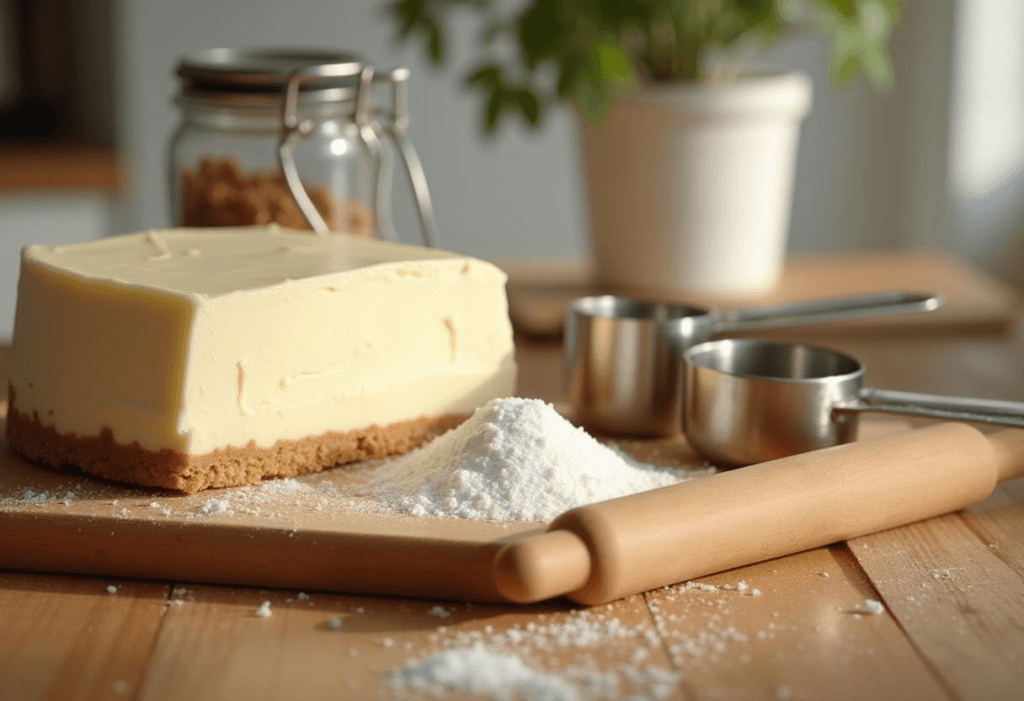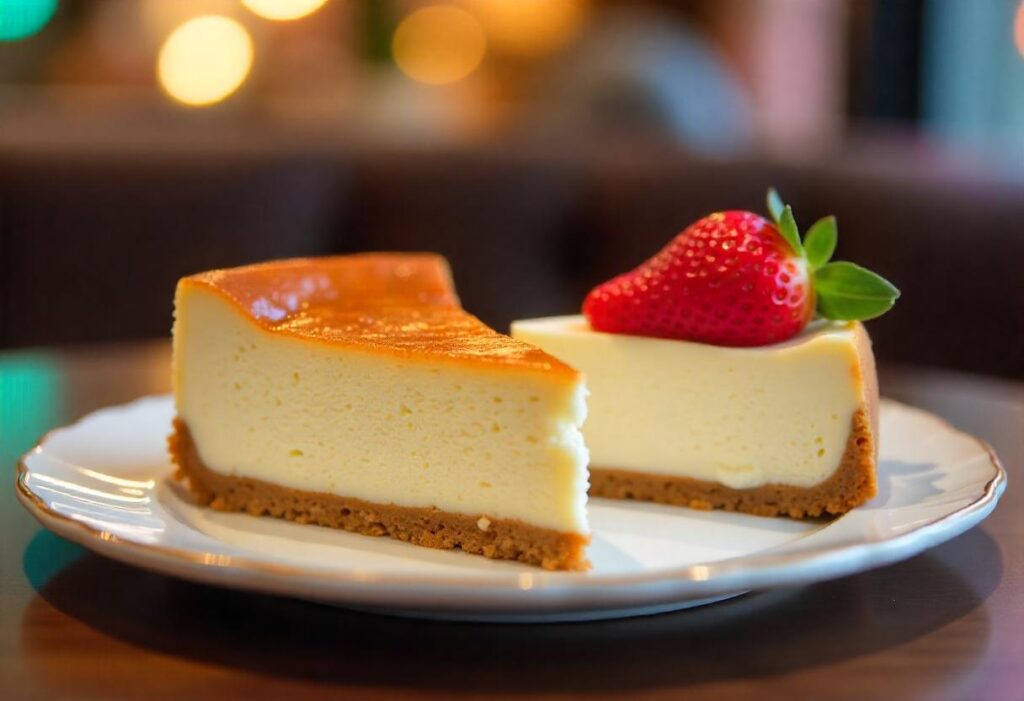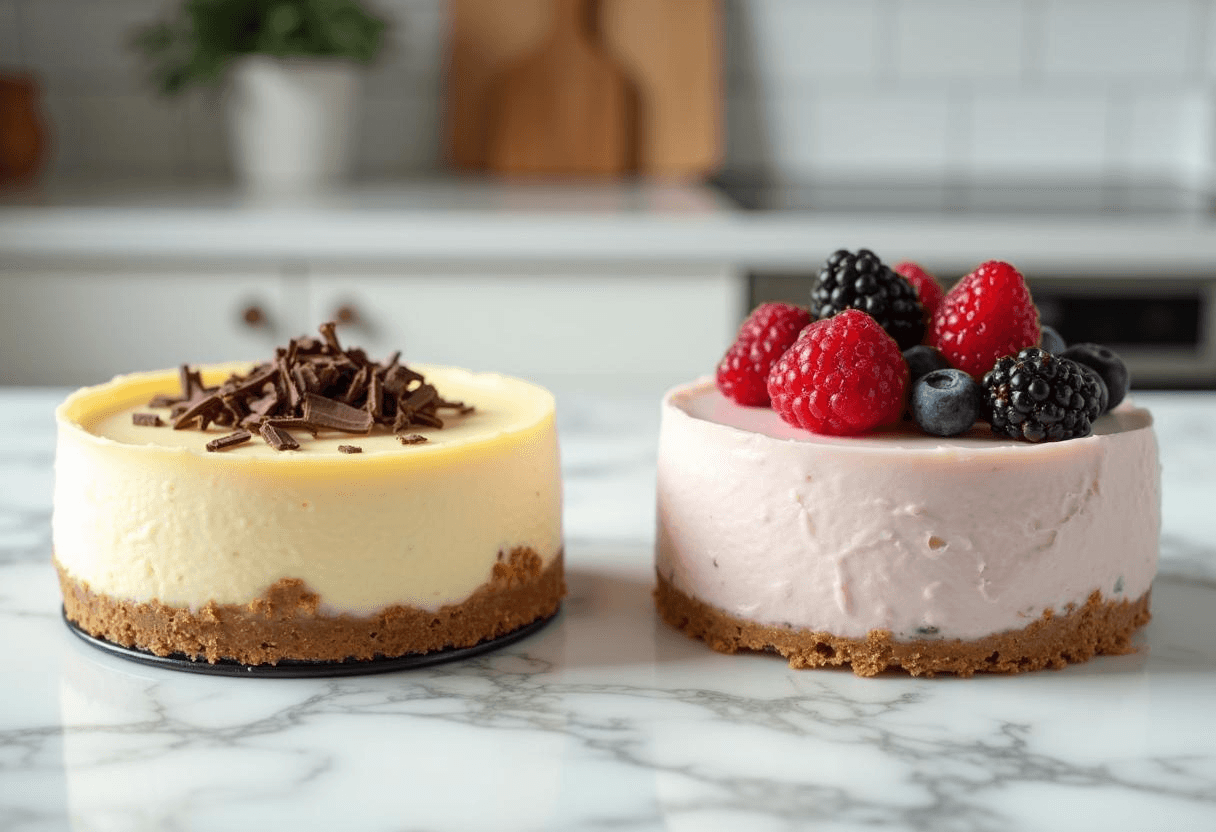Understanding Cheesecake: A Delicious Debate
Cheesecake enthusiasts often find themselves debating one critical question: Is cheesecake better baked or not baked This age-old dilemma highlights the stark differences between the creamy, chilled delight of no-bake cheesecake and the rich, dense indulgence of baked cheesecake. Determining if cheesecake is better baked or not baked requires understanding the distinct characteristics of each preparation method
Before choosing a side, let’s break down the components of both types. If you’re curious about the different styles, check out What Are the Three Types of Cheesecakefor a complete overview.
What Makes a Cheesecake: Ingredients and Basics
Whether baked or not, cheesecakes have similar core ingredients, with key differences in how they set.
For instance, baked cheesecakes rely on eggs for structure, while no-bake cheesecakes use a thickening agent like gelatin or whipped cream. To learn more about what holds a cheesecake together, read What is the Thickening Agent in Cheesecake.

Core Ingredients in Cheesecake Recipes
Here’s what you’ll usually find in most cheesecake recipes:
- Crust: Typically made of crushed cookies (like graham crackers or digestive biscuits), butter, and sugar.
- Filling: A luscious blend of cream cheese, sugar, eggs (for baked versions), and sometimes sour cream or heavy cream.
- Toppings: Fresh fruit, chocolate ganache, whipped cream, or fruit compotes can add flair and extra flavor.
| Ingredients | Quantities |
|---|---|
| Cream Cheese | 16 oz (2 blocks) |
| Sugar | 1 cup |
| Graham Crackers | 1 ½ cups (crumbs) |
| Butter | ½ cup (melted) |
| Eggs (Baked Only) | 3 large |
| Sour Cream (Optional) | 1 cup |
The Appeal of Baked Cheesecake: One Side of the Debate on Is Cheesecake Better Baked or Not Baked
Why Some Prefer the Classic Baked Cheesecake
Many dessert lovers swear by baked cheesecake for its rich texture and complex flavor. The caramelization of sugars and slow baking process enhances the depth of taste.
If you love fruity variations, consider trying a Blackberry Cheesecake Recipe, which showcases how baked cheesecakes can incorporate fresh fruit for a tangy twist.
Imagine pulling a cheesecake out of the oven, its edges slightly golden and the center just set. Doesn’t that sound heavenly? It’s like the difference between eating cookie dough and a freshly baked cookie—both are good, but the baked one has something extra.
« A baked cheesecake is like the little black dress of desserts—timeless and always classy. »

Texture and Flavor Advantages of Baking
Baking changes the game. When baked, the eggs in the filling cook, firming up the texture while still maintaining a creamy consistency. This method gives baked cheesecake its signature dense and luxurious feel. Plus, the flavor tends to be more complex, thanks to the heat-enhanced sugars.
The Charm of No-Bake Cheesecake: The Other Perspective on Is Cheesecake Better Baked or Not Baked
The Simplicity of No-Bake Cheesecakes
No-bake cheesecakes offer a lighter, creamier alternative. They’re great for beginners and don’t require oven time, making them perfect for warm-weather desserts.
If you’re wondering which type suits your needs best, check out Should Cheesecake Be Baked or Not? The Ultimate Guide for an in-depth comparison.
If baked cheesecake is a formal dinner party, no-bake cheesecake is the laid-back backyard barbecue. It’s quick, easy, and approachable.
Texture and Taste Benefits of No-Bake Versions
No-bake cheesecakes are typically lighter and fluffier, with a mousse-like texture. They’re often sweeter too, as they don’t have the caramelized flavors from baking. For those who love creamy desserts with minimal effort, the no-bake version is the winner.
« Think of a no-bake cheesecake as the ultimate cheat day treat—simple, effortless, and oh-so-satisfying. »

Key Differences Between Baked and No-Bake Cheesecakes: Factors to Consider When Asking Is Cheesecake Better Baked or Not Baked
Texture Variations: Creamy vs. Firm
The biggest difference lies in the texture. Baked cheesecakes are firm yet creamy, while no-bake versions are light and airy.
If you love that dense, restaurant-style slice that holds its shape, baked cheesecake is your go-to. But if you’re after a dessert that feels like eating a cloud, no-bake takes the cake.
Want to explore more flavor possibilities? Check out What’s the Best Flavor for Cheesecake? to find the perfect match for your taste buds.
Flavor Intensity and Development
Baking intensifies flavors. The sugar caramelizes, and the tanginess of the cream cheese mellows into a balanced, decadent bite. No-bake cheesecakes are often sweeter and rely on added flavorings like vanilla or lemon juice for complexity.
Preparation Time and Effort
No-bake cheesecakes are quicker to prepare since there’s no need to bake or wait for cooling. They’re a great option for beginners or those short on time. However, baked cheesecakes require patience and a bit more skill—but the reward is worth the effort.
Nutrition Comparison: Baked vs. No-Bake Cheesecake
Both types of cheesecake are indulgent, but they vary slightly in nutrition. Here’s a quick comparison:
| Type | Calories (Per Slice) | Fat | Sugar | Carbs |
|---|---|---|---|---|
| Baked Cheesecake | ~350 | 22g | 22g | 28g |
| No-Bake Cheesecake | ~300 | 20g | 25g | 30g |
Troubleshooting Cheesecake Problems: Challenges in the Is Cheesecake Better Baked or Not Baked Debate
Common Problems with Baked Cheesecakes
- Cracks on the surface: Usually caused by overbaking or rapid cooling.
- Soggy crust: This can happen if the springform pan isn’t properly sealed in a water bath.
- Sunken center: Often a result of underbaking.
Pro Tip: Bake your cheesecake in a water bath to ensure even cooking and a smooth surface!
Typical Issues with No-Bake Cheesecakes
- Runny filling: This happens if the cream cheese isn’t properly whipped or the dessert hasn’t chilled long enough.
- Crumbly crust: Using too little butter in the crust mixture can cause this issue.
Health Considerations: Baked vs. No-Bake Cheesecake
When it comes to indulgent desserts like cheesecake, health isn’t usually the first thing on your mind. But for those who want to enjoy a slice guilt-free, understanding the nutritional differences and healthy alternatives can be helpful.
Nutritional Differences
Baked cheesecake tends to be slightly denser and higher in calories because it often contains eggs, which add richness. No-bake cheesecake, on the other hand, is typically lighter, but it might include whipped cream or sweetened condensed milk, making it higher in sugar.
Both versions are treats, so moderation is key. But if you’re looking for ways to make your cheesecake a little healthier, consider these tips.
Diet-Friendly Alternatives for Both Types
- Low-Fat Cream Cheese: Swap out regular cream cheese for a reduced-fat version to cut down on calories and fat.
- Natural Sweeteners: Use honey, stevia, or maple syrup instead of refined sugar for a more wholesome sweetness.
- Nut-Based Crusts: Replace graham crackers with almond or pecan flour for a gluten-free, lower-carb option.
- Greek Yogurt: Incorporate Greek yogurt into the filling for added protein and a tangy flavor.
« Healthier cheesecake? Yes, please! Small swaps make a big difference without sacrificing flavor. »
When to Choose a Baked Cheesecake
Baked cheesecakes shine in formal settings or when you want to impress your guests. They’re perfect for birthdays, dinner parties, or holidays. The rich, velvety texture feels luxurious, and they pair beautifully with fresh fruit or chocolate drizzle.
Here are a few occasions where baked cheesecake is the better choice:
- Cold Weather Comfort: The dense and warming texture is ideal for winter celebrations.
- Dessert Lovers: For those who appreciate complex, caramelized flavors, baked cheesecake is irresistible.
- Professional Presentation: A well-baked cheesecake with a flawless top looks elegant and professional.
When a No-Bake Cheesecake is the Perfect Choice
No-bake cheesecakes are your best bet when time is short, or you don’t feel like turning on the oven. They’re quick, fuss-free, and perfect for hot weather. Plus, they’re an excellent option for beginner bakers or kids who want to get involved in the kitchen.
Some ideal occasions for no-bake cheesecake include:
- Summer BBQs: Cool and refreshing, no-bake cheesecake is a hit at outdoor gatherings.
- Quick Desserts: When you need a sweet treat in a hurry, this option saves time.
- Creative Fun: No-bake cheesecakes are easily customizable with different flavors and toppings.
« No-bake cheesecake is like the dessert version of a chilled-out weekend—easygoing and just what you need to relax. »
Expert Tips for Making the Perfect Cheesecake
When deciding is cheesecake better baked or not baked, these expert tips will help you perfect either style. Whether you’re team baked or no-bake, these recommendations will elevate your cheesecake game
Tips for Baking a Perfect Cheesecake
- Use Room Temperature Ingredients: Cold cream cheese can cause lumps in your batter, so let it soften before mixing.
- Don’t Overmix: Overmixing adds air to the batter, which can lead to cracks during baking.
- Bake in a Water Bath: A water bath ensures even heat distribution and prevents cracking.
- Cool Gradually: Avoid sudden temperature changes to keep the cheesecake’s surface smooth.
« Baking a cheesecake is like raising a soufflé—it’s an art, and patience is your best friend. »
Tips for Perfecting No-Bake Cheesecakes
- Chill for Long Enough: Let your cheesecake set for at least 4-6 hours or overnight for the best texture.
- Whip the Filling Properly: Ensure the cream cheese and other ingredients are well-blended for a smooth, creamy result.
- Choose the Right Pan: Springform pans make it easy to remove the cheesecake without ruining its shape.
- Experiment with Flavors: Add citrus zest, chocolate, or fruit puree for a creative twist.
Is Cheesecake Better Baked or Not Baked: Final Verdict
So, is cheesecake better baked or not baked The answer depends on your personal preference. If you prefer a rich, firm texture, baked cheesecake is the way to go. But if you love something light and easy to prepare, no-bake cheesecake wins. The question ‘is cheesecake better baked or not baked’ ultimately comes down to your taste preferences, occasion, and cooking comfort level
For a delicious baked variation, try this Ultimate Blackberry Cheesecake Recipe and experience the best of baked cheesecakes.
Here’s how you might decide:
- Go baked if you love dense, classic cheesecake with complex flavors.
- Go no-bake if you’re after a quick, creamy dessert that’s lighter and fluffier.
« In the end, there’s no wrong choice. Whether baked or not, cheesecake is always a win! »
Pairing Cheesecake with Toppings: Elevate Your Dessert
One of the best things about cheesecake—baked or no-bake—is how versatile it is when it comes to toppings. A well-chosen topping can enhance the flavor, add visual appeal, and create a unique dessert experience.
Classic Toppings for Baked Cheesecake
Baked cheesecakes pair wonderfully with toppings that complement their rich and dense texture. Here are some popular options:
- Fresh Fruits: Strawberries, raspberries, or blueberries add a tangy, refreshing contrast.
- Chocolate Ganache: A drizzle of warm ganache adds decadence and pairs beautifully with a plain cheesecake.
- Caramel Sauce: The buttery sweetness of caramel can take your cheesecake to the next level.
- Nuts: Crushed pecans or almonds add crunch and a nutty flavor.
« Toppings on a baked cheesecake are like accessories to an outfit—they take it from good to unforgettable! »
Creative Toppings for No-Bake Cheesecake
No-bake cheesecakes often embrace lighter, creamier toppings that match their fluffy texture. Some fun ideas include:
- Whipped Cream Swirls: Add a dollop of whipped cream for an airy finish.
- Fruit Coulis: A smooth fruit puree drizzled on top enhances the dessert’s sweetness.
- Candy or Cookie Crumbles: Crushed Oreos, toffee, or even M&M’s make for a playful and indulgent treat.
- Edible Flowers: For a fancy twist, add edible flowers like violets or pansies.
Regional Cheesecake Variations: Baked and No-Bake Around the World
Regional variations offer unique perspectives on the question of is cheesecake better baked or not baked across different culinary traditions. Cheesecake’s popularity spans the globe, with different regions offering their own take on this classic dessert. Understanding these variations might even help you decide which style suits your palate best
New York Cheesecake (USA)
The most iconic baked cheesecake, New York-style, is dense, rich, and creamy. It’s often served plain or with a simple fruit topping to let the flavors shine.
Japanese Cheesecake
This light and fluffy version of baked cheesecake almost resembles a soufflé. It’s known for its airy texture and delicate sweetness, making it a great alternative to heavier cakes.
Italian Ricotta Cheesecake
In Italy, cheesecake is typically made with ricotta cheese, resulting in a drier texture and a slightly tangier flavor. This baked dessert often includes citrus zest or almond extract for added complexity.
German Käsekuchen
This baked cheesecake uses quark (a type of soft cheese) instead of cream cheese. It has a lighter texture and is often flavored with vanilla or lemon.
No-Bake Fridge Cakes (UK)
In the UK, no-bake cheesecakes are immensely popular, often featuring a digestive biscuit crust and flavored fillings like lemon, chocolate, or berries.
« Every country’s cheesecake tells a story—why not taste your way around the world? »
Cheesecake Storage Tips: Keep It Fresh
Whether you’ve decided cheesecake is better baked or not baked, proper storage is essential for maintaining freshness. Both baked and no-bake varieties need care to stay delicious
Baked Cheesecake Storage
- Refrigeration: Always refrigerate baked cheesecake. Wrap it tightly in plastic wrap or store it in an airtight container to prevent it from drying out.
- Shelf Life: A baked cheesecake can last up to 5-7 days in the fridge. For longer storage, freeze it.
- Freezing Tips: Freeze individual slices or the whole cheesecake. Wrap it in plastic wrap, then aluminum foil, and store it in a freezer-safe bag.
No-Bake Cheesecake Storage
- Refrigeration: No-bake cheesecake must be kept chilled to maintain its texture. Store it in the fridge for up to 3-5 days.
- Freezing: While freezing is possible, it might slightly alter the creamy texture. If freezing, follow the same steps as for baked cheesecake.
« Think of cheesecake as a guest at a party—it needs the right environment to shine! »
Cheesecake Fun Facts: Did You Know?
Cheesecake isn’t just a dessert—it has a fascinating history and some quirky trivia attached to it. Here are some fun facts:
- Ancient Origins: Cheesecake dates back to ancient Greece. Athletes at the first Olympic Games were served a version of cheesecake as an energy boost.
- World’s Largest Cheesecake: In 2009, Mexico broke the record by creating a cheesecake weighing over 4,500 pounds!
- Cheesecake Day: There’s an entire day dedicated to this dessert. Celebrate National Cheesecake Day on July 30th each year.
- Not Always Sweet: Some savory versions exist, especially in European cuisines, incorporating ingredients like herbs or vegetables.
Frequently Asked Questions About Cheesecake
What makes baked cheesecake denser than no-bake cheesecake?
Baked cheesecake uses eggs in the filling, which set during baking and give the dessert its dense, velvety texture.
Can I freeze no-bake cheesecake?
Yes! No-bake cheesecake freezes well. Wrap it tightly to prevent freezer burn and thaw in the fridge before serving.
Why did my baked cheesecake crack?
Cracks are usually caused by overbaking or cooling the cheesecake too quickly. A water bath can help prevent this issue.
Do I need gelatin for no-bake cheesecake?
Not necessarily. While some recipes use gelatin to help the filling set, others rely on the firmness of the cream cheese and whipped cream.
Which cheesecake is healthier?
No-bake cheesecakes tend to be lighter in texture and slightly lower in calories, but both types are treats and should be enjoyed in moderation.
Can I customize cheesecake flavors?
Absolutely! Whether baked or no-bake, cheesecake is a versatile dessert that can be flavored with chocolate, fruit, spices, or even coffee.
How do I decide if cheesecake is better baked or not baked for my specific occasion?
Consider your time constraints, skill level, and texture preference. Baked cheesecakes are ideal for formal events and cooler weather, while no-bake versions are perfect for beginners, summer gatherings, and when you need a quick dessert
Conclusion
Cheesecake is one of life’s greatest culinary joys, and both baked and no-bake versions have their merits. Whether you’re a fan of the classic baked richness or the creamy, effortless no-bake style, there’s no denying that cheesecake—no matter how it’s prepared—is simply delicious. So, why not try both and let your taste buds decide? After all, you deserve a slice of happiness. 😊

